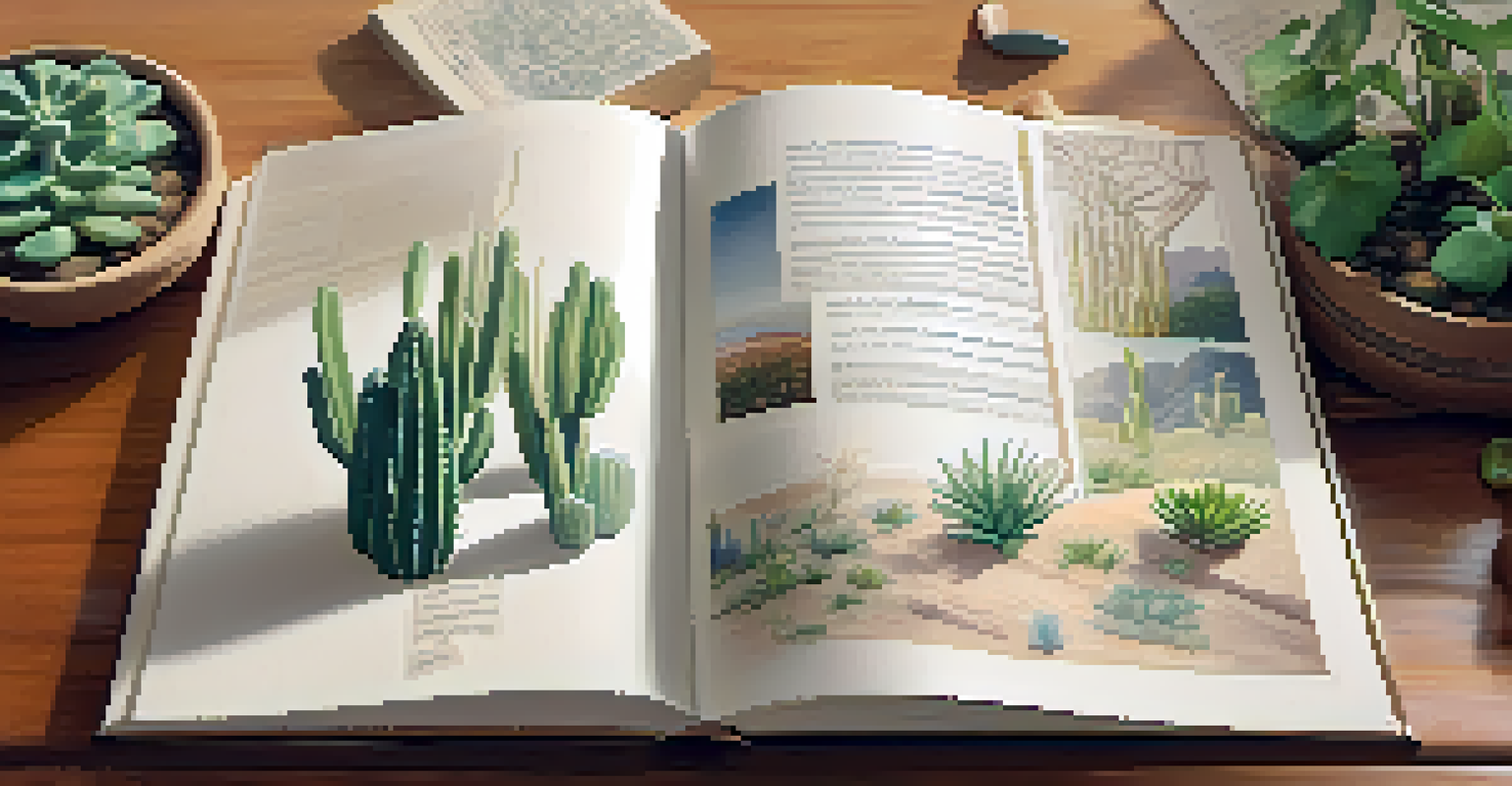Peyote Rituals: Nature as a Vital Component of Healing

Understanding Peyote: A Brief Overview of Its Significance
Peyote, a small cactus native to Mexico and the southwestern U.S., has been used for centuries in spiritual practices. It contains mescaline, a psychoactive compound that induces altered states of consciousness. These experiences are often considered sacred, leading to profound insights and emotional healing during rituals. The significance of peyote extends beyond its physical properties; it embodies a deep connection to nature and the universe.
Nature does not hurry, yet everything is accomplished.
In many Indigenous cultures, peyote is more than just a plant; it's a teacher and a guide. Participants in peyote rituals often seek guidance for personal issues or communal challenges. This connection to nature fosters a sense of belonging and purpose, which is essential for healing. By engaging with peyote, individuals can explore their inner landscapes and confront their emotions in a safe environment.
The ritual use of peyote offers a unique opportunity to reconnect with the natural world. As participants consume the cactus in a ceremonial setting, they often experience visions that highlight their relationship with nature. This transformative experience underscores the importance of the natural world in the healing process, reminding us that we are all part of a larger ecosystem.
The Role of Nature in Peyote Healing Practices
Nature plays a vital role in peyote rituals, serving as both a backdrop and a crucial element in the healing process. The rituals typically take place in natural settings, allowing participants to immerse themselves in the sights and sounds of the environment. This connection with nature enhances the spiritual experience, fostering a sense of peace and grounding. It’s as if the very earth supports the journey of healing.

When participants engage with peyote, they often report feeling more attuned to the rhythms of nature. This heightened awareness can lead to a deeper understanding of one's place in the world. As individuals undergo their journeys, they may find clarity in their thoughts and emotions, much like a river flowing smoothly after a storm. The natural environment acts as a comforting presence, facilitating emotional release and self-discovery.
Peyote as a Spiritual Teacher
Peyote serves as more than just a plant; it acts as a guide in spiritual rituals, helping individuals navigate personal and communal challenges.
Moreover, the rituals often include traditional songs, prayers, and stories that celebrate nature's beauty and wisdom. These elements reinforce the bond between the participants and the earth, creating a sacred space for healing. In this way, nature is not just a setting but an active participant in the healing process, reminding us of the interconnectedness of all living things.
Cultural Context: The Tradition of Peyote Use
Peyote rituals are deeply rooted in the traditions of various Indigenous cultures, particularly among Native American tribes. These rituals have been passed down through generations, preserving ancient knowledge and practices. Each tribe may have its own unique approach to peyote use, but the underlying themes of healing and connection to nature remain constant. This rich cultural context adds layers of meaning to the experience.
The clearest way into the Universe is through a forest wilderness.
The use of peyote is often framed within a larger spiritual framework, where it is seen as a gift from the earth. This perspective fosters respect and reverence for the plant, as well as for the environment in which it grows. Participants are taught to honor the peyote and its role in their healing journeys, which in turn encourages a sense of stewardship towards nature. This relationship is vital for the sustainability of both the plant and the cultural practices surrounding it.
As modern society becomes increasingly disconnected from nature, the peyote rituals serve as a reminder of the importance of these ancient traditions. They emphasize the value of communal support in healing, highlighting how nature and culture work hand in hand. By participating in these rituals, individuals not only seek personal healing but also contribute to the preservation of a rich cultural heritage.
The Psychological Benefits of Peyote in Healing
The psychological benefits of peyote rituals are profound and multifaceted. Many participants report experiencing deep emotional release, often confronting long-standing traumas or anxieties during their journeys. This cathartic experience can lead to significant psychological healing, allowing individuals to move forward with a renewed sense of hope and clarity. It’s akin to lifting a heavy weight off one’s shoulders, making space for new perspectives.
Research has shown that substances like mescaline can facilitate a sense of interconnectedness and unity with the world. This feeling often results in reduced symptoms of anxiety and depression, providing a natural alternative to traditional therapies. The altered state of consciousness induced by peyote allows individuals to explore their thoughts and feelings in a non-linear way, fostering insights that might not surface in everyday life. It’s a journey that can lead to lasting change.
Nature's Role in Healing
The immersive natural settings of peyote rituals enhance the spiritual experience, fostering a deep connection to the environment that supports emotional healing.
In essence, peyote rituals create a sacred space for introspection and healing. Participants often share their experiences with one another, forming bonds that provide additional emotional support. This communal aspect further enhances the healing process, as individuals realize they are not alone in their struggles. By embracing both the psychological benefits and the natural environment, peyote rituals offer a holistic path to healing.
Navigating Challenges: The Journey of Healing with Peyote
Healing with peyote is not without its challenges. Participants often face difficult emotions and memories that can arise during the experience. While this process is essential for growth, it can also be overwhelming. Having the support of experienced guides and a safe environment is crucial to help individuals navigate these turbulent waters. It’s important to remember that, like a storm passing through, challenges can lead to clearer skies.
Moreover, the intensity of the peyote experience varies from person to person. Some may have profound epiphanies, while others might feel lost or confused. This variability can lead to feelings of frustration or disappointment, especially if expectations are not met. However, these challenging moments often serve as important lessons in resilience and self-acceptance. Embracing the full spectrum of the experience is key to personal growth.
Ultimately, the journey of healing with peyote is a deeply personal one. Each individual's path is unique, shaped by their experiences and emotions. Acknowledging the challenges as part of the healing process allows participants to cultivate patience and compassion for themselves. Just as nature thrives through cycles of growth and decay, so too can individuals find strength in their healing journeys.
Integration: Bringing Lessons from Peyote Rituals into Daily Life
The process of integrating lessons learned during peyote rituals into daily life is a vital step in the healing journey. After experiencing profound insights, individuals often feel inspired to make changes in their lives. However, translating these insights into actionable steps can be challenging. It's essential to approach this integration with patience and intention, allowing the lessons to unfold naturally over time.
Many participants find that journaling, meditation, or sharing their experiences with others helps solidify their insights. These practices can serve as anchors, reminding them of the clarity gained during the peyote experience. Additionally, staying connected to nature through regular outdoor activities can help maintain that sense of unity and grounding. Just as a tree needs its roots, individuals can benefit from nurturing their connection to the earth.
Cultural Significance of Rituals
Peyote rituals are rooted in Indigenous traditions, emphasizing the importance of cultural heritage and communal support in the healing process.
Ultimately, the integration process is about weaving the wisdom gained from peyote rituals into the fabric of everyday life. This may involve setting new goals, fostering healthier relationships, or adopting mindful practices. By embracing the lessons of healing, individuals can continue to grow and thrive long after the ritual has ended, creating a life enriched by their experiences with peyote.
Conclusion: Embracing Nature's Role in Personal Healing
In conclusion, peyote rituals highlight the profound impact nature has on personal healing. By connecting with the earth and engaging in these traditional practices, individuals can access deep emotional and psychological healing. The experience of peyote serves as a reminder of our intrinsic connection to nature and the wisdom it offers. It’s an invitation to explore the depths of our being while honoring the natural world.
As we navigate the complexities of modern life, embracing nature's role in healing becomes increasingly important. Peyote rituals, steeped in cultural significance, provide a pathway for individuals to reconnect with themselves and the environment. By acknowledging the healing power of nature, we open ourselves to transformative experiences that can shape our lives in meaningful ways.

Ultimately, the journey of healing with peyote is a testament to the resilience of the human spirit. It reminds us that we are part of a larger tapestry of life, where nature serves as both a guide and a healer. As we continue to explore these sacred practices, let us carry the lessons learned into our daily lives, fostering a deeper appreciation for the interconnectedness of all beings.